Rabies Lyssavirus
Introduction
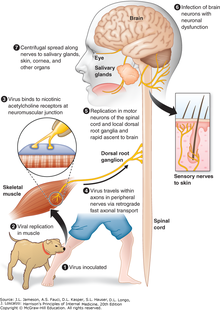
Rabies Lyssavirus, commonly known as the Rabies virus, is a bullet-shaped neurotropic virus that causes rabies in mammals.[1]
In North America, bats are the leading carrier for the Rabies virus, while dog bites are the most common causes in other parts of the world. Once the Rabies virus is transmitted through bite or saliva of rabid animals, it will replicate in patients’ muscle tissue, then transmit to the central nervous system(CNS)through the axons of the peripheral nerves. Once the Rabies virus arrives at the brain, it will infect the brain neurons which eventually lead to encephalitis.[2] If bites from rabies-infected animals did not receive immediate care, and rabies symptoms (aggressiveness, hallucinations, fever, nausea, foaming at the mouth, fear of water) start to appear in patients, it is usually fatal.[3]
Rabies virus is preventable for humans through vaccination or fast-acting shot that contains rabies immune globulin for those who got bitten recently. Other mammals such as human-pet dogs and cats can also get the treatment for the prevention of rabies virus.[4]
Vaccination for rabies virus is well delivered in developed countries, while it is less accessible in less developed countries around the globe. While preventable through vaccination, there is currently no cure for the Rabies virus, and it carries approximately 55,000 lives away each year.[5]Scientists are actively researching for a possible cure for the rabies virus.
Structure
Rabies Virus (RABV) belongs to the family Rhabdoviruses and the genus Lyssavirus. RABV is a bullet-shaped RNA virus that is about 180 nm in length and 75 nm in width. The "bullet" contains one copy of an enveloped single-stranded non-coding RNA genome that contains about 12,000 nucleotides.[6]The two significant components of the Rabies virus are the ribonucleoprotein complex(RNP) and the surrounding cell envelope. Out of the five proteins, nucleoprotein(N), Phosphoprotein(P), and Polymerase protein(L) are associated with the RNP. The matrix protein is responsible for covering and keeping the RNP in a condensed form. The rabies virus envelope is constructed of a phospholipid bilayer with glycoprotein spikes.[6]
RABV genome encodes five essential structural proteins:
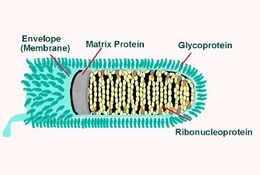
Nucleoprotein(N):
The nucleoprotein encapsidates the non-coding RNA genome to form the nucleocapsid core. The nucleocapsid core, along with polymerase protein and phosphoprotein, constructs the ribonucleoprotein complex(RNP).[2]RNP is responsible for the protection of the rabies virus genome from RNA degradation caused by ribonuclease. Other than genome protection, nucleoprotein is also an antigen for viruses due to their group and strain-specific antigenic determinants.[7]
Phosphoprotein(P):
The phosphoprotein (P) plays a key role in the replication of RABV viral RNA by being the cofactor of an essential enzyme RNA-dependent RNA polymerase (RdRP). The phosphoprotein accomplishes the key RNA synthesis by connecting the nucleoprotein and the polymerase protein in the ribonucleoprotein complex.[8]
Recent research from 2013 revealed that in the strain Nishigahara, P protein is involved in the neuroinvasive of the Rabies virus by mediating the peripheral nerve infection, which caused lethal results in intramuscular inoculated mice. However, the P protein from the derivative strain Ni-CE, while also causing lethal results in mice, was not significant for the stable viral replication process in the host’s muscle cells. It was later investigated that the Nishigahara P protein gene was able to counteract the host interferon(IFN) system, which is responsible for interfering with the viral replication process to protect host cells from infection. [9] The Nishigahara P protein was able to suppress the gene expression of beta interferon and IFN-stimulates genes in the host mice muscle cells. Thus, the infection of the peripheral nerves is enhanced by the Nishigahara P protein. [10] However, it is to be further investigated about the suppression effect with other Rabies Virus strains P protein.
Polymerase protein(L):
Polymerase protein is responsible for the transcription of the RABV RNA. During transcription, the L protein will transcribe the viral RNA into leader RNA and five mRNAs that are each capped and polyadenylated. The RNA-dependent RNA polymerase protein is a potential target for rabies treatment because it produces all viral proteins for RABV and requires interaction with other viral proteins for the primary transcription.[11]

Matrix Protein(M):
Matrix protein locates on RABV’s inner envelope. It has been known for two decades that matrix protein is responsible for interaction with glycoprotein. M protein recruits RNPs, whose condensation forms the budding of the bullet-shaped particles.[12] The membrane matrix protein is later known for being a factor for the balance of RABV transcription and replication through inhibiting transcription and stimulating the replication process.[13]
Glycoprotein(G):
The translation of G protein is taken place on hosts’ endoplasmic reticulum bound ribosomes.[14] The glycosylated G-protein Forms glycoprotein spikes on the virus’s outer envelope, which allows the virus to be recognized and aid in its binding to host cells.[15]Glycoprotein has the ability to activate the immune system following the production of antibodies, which has been used in a beneficial way for the production of recombinant vaccines. [14]
History
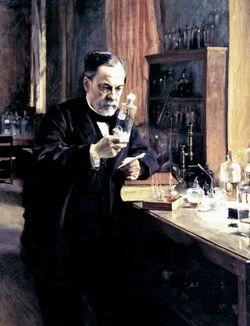
Rabies is an ancient disease. It was called "lyssa" by the ancient Greeks, which means violence. Rabies was first mentioned in text coming from 2300 B.C. when people in Babylon found the death of humans and dogs were related to getting bid by a dog. After the discovery, if a Babylonians dog transmitted another person’s rabies, the dog owner had to pay a fine for it.
Back in the first century A.D., the transmission method of rabies was correctly suggested by Roman scholar Celsus. A cure, however, is yet to be found even with the well-developed scientific field in the 21st century. Back in ancient times, various remedies are being suggested: Celsus suggested holding the patient underwater. Others have suggested laying the rabid dog hair on the patient or letting the patient ingest rabid dog hair. Going into the 18th century, Madstones, which are hairballs found in the ruminants stomachs, were thought to be a valuable rabies treatment. It was reported that in 1849, Abraham Lincoln's son Robert was bitten by a rabid dog and survived with the Madstone treatment, however, the reliability of the report is to be considered.
The first treatment was introduced by Louis Pasteur(Figure 4), a french chemistry teacher. After dabbling with chicken cholera, which is a rapid spreading commonly found in chicken yards, he noticed one of the old virulent cultures no longer caused disease when it was inoculated into a chicken. Pasteur later inoculates a group of chicken with the old virulent culture and left another group of chicken without the inoculation. With some fresh chicken cholera injected to all chickens, those with inoculation survived while the other did not. At that time, Pasteur concluded that the inoculated chicken has used the weaker strains of virulent culture to improve their immunity against the fresh germs. With his chicken cholera experiment, Pasteur found a way to help others become immune without a risk of getting the disease. [16] he then continues on with anthrax vaccine for cattle and vaccine for rabies.
The first human being treated successfully with this vaccine was a 9-year-old boy named Joseph Meister, who was scratched by a rabid dog. Joseph recovered after receiving 13 inoculations in 11 days from Pasteur. After the success in 1885, the post-exposure vaccine was being actively researched by scientists and widely used by over 20,000 people.[17]The first available inactivated Rabies vaccine was developed in 1908 and it is estimated by the World Health Organization that the vaccine saves more than 270,000 lives per year. [18]Today, the post-exposure prophylaxis (PEP), which consists of human rabies immune globulin and rabies vaccine is still being used as the standard post-treatment for rabies. It is given on the exposure day to the rabies virus. Three doses of the rabies virus would be given to the patients on days 3, 7, and 14. [19]
Vaccination
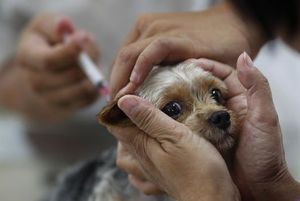
The rabies vaccine is universal today and is divided into preventive vaccination and post-exposure vaccination. Between 15,000 and 40,000 people are vaccinated each year after a possibly rabid animal bite. Bites from unvaccinated dogs cause most of the rabies-related death cases. The Rabies vaccine is universal today and is divided into preventive vaccination and post-exposure vaccination. Between 15,000 and 40,000 people are vaccinated each year after a possibly rabid animal bite. Globally speaking, Bites from unvaccinated dogs cause most of the rabies-related death cases.[4]It is required for mammal pet owners (examples are dogs and cats owners) in the United States to have their pets vaccinated for rabies. Animals coming from high-risk countries for rabies virus need rabies vaccine certificates to enter the State. [20]
Preventive Vaccination
mmm
Post-exposure vaccination
mm
vac option for pets and mammals, pro and con, difference between human and pets vac
to be updated
Evolution
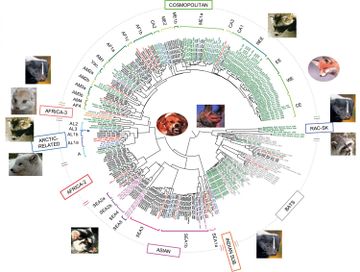
To be updated
Case Study
Although most of the untreated patients of rabies died, there were a few cases that stood out where the patient has not treated pre or post-exposure to the rabies virus, they still survived. We are going to focus on the story of Jeanna Giese.
Jeanna Giese
Jeanna Giese, then mentions other cases without detail, just to support. focus: milktreatment-def, how it hypo works

To be updated
Research
Research directions: permeability of the blood-brain barrier, central nervous system. Rabies virus outer shell, which is unable to cause disease, can be used in other medical fields.
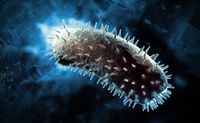
to be updated
Conclusion
Overall text length should be at least 1,000 words (before counting references), with at least 2 images. Include at least 5 references under Reference section.
References
- ↑ Rabies - Symptoms and causes [Internet]. Mayo Clinic. 2019. Available from: https://www.mayoclinic.org/diseases-conditions/rabies/symptoms-causes/syc-20351821
- ↑ 2.0 2.1 Long, S., Prober, C. and Fischer, M. (2012). Principles and practice of pediatric infectious disease. 4th ed. Saunders.
- ↑ Kidshealth.org. (2019). Rabies (for Parents) - Nemours KidsHealth. [online] Available at: https://kidshealth.org/en/parents/rabies.html.
- ↑ 4.0 4.1 Rabies Vaccine [Internet]. Cdc.gov. 2009. Available from: https://www.cdc.gov/vaccines/hcp/vis/vis-statements/rabies.pdf
- ↑ Is Rabies Really 100% Fatal? | Viruses101 | Learn Science at Scitable [Internet]. Nature.com. 2013. Available from: https://www.nature.com/scitable/blog/viruses101/is_rabies_really_100_fatal/
- ↑ 6.0 6.1 What is Rabies? | Rabies | CDC [Internet]. Cdc.gov. 2019. Available from: https://www.cdc.gov/rabies/about.html.
- ↑ Koser M, McGettigan J, Tan G, Smith M, Koprowski H, Dietzschold B et al. Rabies virus nucleoprotein as a carrier for foreign antigens. Proceedings of the National Academy of Sciences [Internet]. 2004;101(25):9405-9410. Available from: https://www.pnas.org/content/101/25/9405
- ↑ Okada K, Ito N, Yamaoka S, Masatani T, Ebihara H, Goto H et al. Roles of the Rabies Virus Phosphoprotein Isoforms in Pathogenesis. Journal of Virology [Internet]. 2016;90(18):8226-8237. Available from: https://jvi.asm.org/content/90/18/8226
- ↑ DE ANDREA, M., RAVERA, R., GIOIA, D., GARIGLIO, M. and LANDOLFO, S. (2002). The interferon system: an overview. European Journal of Paediatric Neurology, [online] 6, pp.A41-A46. Available at: https://www.sciencedirect.com/science/article/pii/S1090379802905738?via%3Dihub
- ↑ Yamaoka, S., Ito, N., Ohka, S., Kaneda, S., Nakamura, H., Agari, T., Masatani, T., Nakagawa, K., Okada, K., Okadera, K., Mitake, H., Fujii, T. and Sugiyama, M. (2013). Involvement of the Rabies Virus Phosphoprotein Gene in Neuroinvasiveness. Journal of Virology, [online] 87(22), pp.12327-12338. Available at: https://www.ncbi.nlm.nih.gov/pubmed/24027304.
- ↑ Nakagawa K, Kobayashi Y, Ito N, Suzuki Y, Okada K, Makino M et al. Molecular Function Analysis of Rabies Virus RNA Polymerase L Protein by Using an L Gene-Deficient Virus. Journal of Virology [Internet]. 2017;91(20). Available from: https://www.ncbi.nlm.nih.gov/pmc/articles/PMC5625484/
- ↑ Mebatsion T, Weiland F, Conzelmann K. Matrix Protein of Rabies Virus Is Responsible for the Assembly and Budding of Bullet-Shaped Particles and Interacts with the Transmembrane Spike Glycoprotein G [Internet]. Journal of Virology. 1999. Available from: https://jvi.asm.org/content/73/1/242.long
- ↑ Finke S, Mueller-Waldeck R, Conzelmann K. Rabies virus matrix protein regulates the balance of virus transcription and replication. Journal of General Virology [Internet]. 2003;84(6):1613-1621. Available from: https://www.microbiologyresearch.org/docserver/fulltext/jgv/84/6/1613.pdf?expires=1575256460&id=id&accname=guest&checksum=8E3AA286D649C7B0CAF0AAF05D0D07DC
- ↑ 14.0 14.1 Cherian S, Singh R, KP S. Rabies Glycoprotein: A Benefit to the Virus, us or both? [Internet]. Rroij.com. 2015. Available from: http://www.rroij.com/open-access/rabies-glycoprotein-a-benefit-to-the-virus-us-or-both.php?aid=58725
- ↑ Dietzschold B e. Structure and function of rabies virus glycoprotein. - PubMed - NCBI [Internet]. Ncbi.nlm.nih.gov. 1978. Available from: https://www.ncbi.nlm.nih.gov/pubmed/680401
- ↑ Chicken cholera | ari.info | ari.info [Internet]. ari.info. 2015. Available from: http://www.animalresearch.info/en/medical-advances/veterinary-medicine/chicken-cholera
- ↑ O'Niell F. A History of Rabies [Internet]. Tuckahoevet.com. Available from: https://www.tuckahoevet.com/post/a-history-of-rabies
- ↑ Society M. Rabies virus: can we treat the untreatable? [Internet]. Microbiologysociety.org. 2019. Available from: https://microbiologysociety.org/blog/rabies-virus-can-we-treat-the-untreatable.html
- ↑ Rabies Postexposure Prophylaxis (PEP) | Medical Care | Rabies | CDC [Internet]. Cdc.gov. 2019. Available from: https://www.cdc.gov/rabies/medical_care/index.html
- ↑ Rabies Vaccine Certificate Required When Coming From These High-Risk Countries | Bringing an Animal into U.S. | Importation | CDC [Internet]. Cdc.gov. 2019. Available from: https://www.cdc.gov/importation/bringing-an-animal-into-the-united-states/rabies-vaccine.html
Edited by Yangyang Liu, student of Joan Slonczewski for BIOL 116 Information in Living Systems, 2019, Kenyon College.
